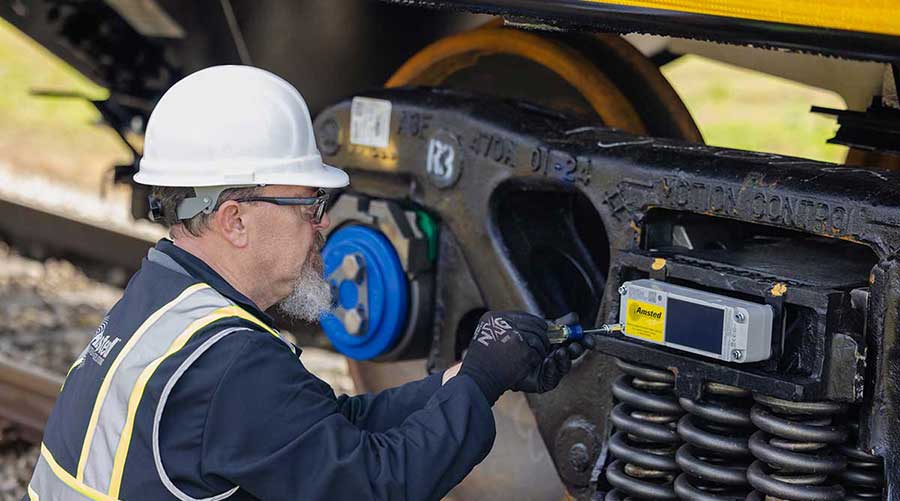Stay updated on news, articles and information for the rail industry
March 2010
Rail News: Rail Industry Trends
Class Is keep the corporate diversity flame burning
By Julie Sneider
Cindy Sanborn is the face of the changing Class I workforce. At 44, Sanborn was promoted in November 2009 to vice president and chief transportation officer at CSX Transportation. CSXT officials say she is one of the highest-ranking female executives at a U.S. railroad. She's also a prominent example of Class Is' aggressive approach to recruiting and retaining a workforce that more accurately reflects a cross section of North America.
"It's [no longer] expected to be a male-dominated or male-oriented workforce," Sanborn says of an industry that she believes offers a perfect mix of "gratifying, challenging and interesting work."
It's also one of many industries that hasn't done a lot of hiring during the past 18 recessionary months. Several thousand Class I workers remained on furlough as of early February.
Even so, Class Is are staring at a baby-boom generation of rank-and-filers, managers and executives — primarily white and male — who are likely to retire during the next five to 10 years. Add to that an anticipated 67 percent jump in freight-rail demand by 2020, and rail CEOs, human resource executives and chief diversity officers recognize their companies must forge ahead with their proclaimed commitments to diversity and human capital development.
At a minimum, railroads are working on carrying out diversity plans within their own employment ranks, moving forward with employee training and education, and stepping up outreach to an increasingly diverse base of customers and suppliers.
"Diversity is not at all on hold in a recession," says Kim Madigan, CN's vice president-human resources. "We think of diversity in two sections: hiring and developing talent. Even in a recession and when we're not hiring, we're developing talent."
In The Military They Trust
Depending on the pace of economic recovery and worker retirements, CN expects to replace almost half of its employee population during the next five years. CN execs see it as a chance to reengineer recruitment and hiring practices, Madigan says.
Since 2001, CN's Diversity Leadership Council has been reviewing and removing employment barriers. The Class I's actions include expanded support of U.S. and Canadian organizations that encourage diversity; scholarships for women and Aboriginal college students seeking transportation industry-related degrees; recruitment of minority engineering students to CN's summer intern program; and participation in career fairs for military veterans and people about to leave the armed forces to enter the job market.
Many railroads have focused heavily on recruiting military personnel in recent years as part of their diversity strategies. The military isn't merely a source of diverse candidates — of those on active duty in the U.S. Armed Forces in 2007, about 14 percent were women and 36 percent were minorities — military personnel also possess the skills, training, discipline and work ethic that railroads seek in their employees.
Railroads have been so aggressive at recruiting veterans and military members that G.I. Jobs magazine ranked Union Pacific Railroad first, CSXT second, BNSF Railway Co. fourth and Norfolk Southern Railway seventh among the Top 10 most "military-friendly employers" for 2009. What did they do to earn that recognition? UP set up a new military task team to craft a military recruiting plan. At CSXT, nearly one in four new hires is a veteran and among current employees, one in five is a veteran.
The military chapter is but one in the rail realm's still-unfolding diversity story. BNSF Assistant Vice President of Human Resources Ed McFalls characterizes his road's own saga as a "never-ending journey." What started in the mid-1990s as an effort by African-Americans to improve their opportunities for advancement at BNSF has evolved into a company-wide approach that stretches beyond race, gender, ethnicity or age.
"The bottom line is, we view diversity as a business necessity and a business opportunity," says McFalls. "We operate across 28 states in the United States and many of these communities are diverse. We are a diverse nation. Why would you not want to be a diverse company?"
In practice, diversity means "accepting, evaluating and utilizing the similarities" that people from different backgrounds bring to the company so that all can work safely and productively across "cultural, geographic and functional boundaries," McFalls says.
BNSF Chairman, President and Chief Executive Officer Matt Rose's executive diversity council sets the stage for the company's diversity plans. At the employee level, BNSF has organized "affinity groups" for African-Americans, women, Native Americans, Asian-Americans and Hispanics that assist with employee recruitment, retention and community relations. On a local level, the company's 16 regional councils review diversity issues, host diversity celebrations and assist with recruitment at job fairs.
Working with women- and minority-owned businesses also is a major component of the Class I's plan. BNSF's Diverse Business Enterprise program has grown since the mid-1990s; for example, in 2007, the railway added a new initiative to encourage suppliers to increase their spending with minority- and women-owned companies.
But for any corporate diversity to have real staying power, the message has to come from the top, McFalls and other diversity officers say. Without CEO buy-in, diversity is just lip service.
At NS, Chairman, President and CEO Wick Moorman stresses the importance of diversity in a message on the company Web site, directing all employees to use diversity to "achieve better business outcomes." A Diversity Council formed in 2002 carries out NS' diversity strategies and activities, says David Cobbs, assistant vice president diversity and EEO. The council's 35 members represent the entire organization, from executives to union reps, and come from a cross-section of geographic areas and business groups. The council's work is divided into three smaller teams: education and training, diversity awareness activities and communication. A fourth team — recruitment — was in place until last year when the recession stopped nearly all hiring.
Diversity Advocates
Although recruitment may be less of a factor in the slow economy, progress on the diversity front manifests itself in other ways. At CSX Corp., Chairman, President and CEO Michael Ward remains an outspoken advocate for diversity, tying 20 percent of senior executives' bonuses to diversity goals, reports DiversityInc., which ranked CSX one of the magazine's Top 50 best employers for diversity in 2008 and 2009.
The Class I recognized in the 1990s that it was "behind the eight ball" with respect to attracting more women and non-white males, says Susan Hamilton, CSXT diversity officer and assistant vice president. But it wasn't until the early-to-mid 2000s that CSXT finally started "in earnest" to focus on becoming an "employer of choice" for top-flight talent and a leading company for diversity, she says.
To achieve its goal, CSXT crafted a comprehensive plan comprising outreach programs and mandatory diversity and inclusion training for employees at all levels. The firm's "diversity" groups and councils were revamped into "inclusion" groups and councils that assist in recruiting personnel and setting business goals. Today, CSXT has inclusion councils and groups for African-Americans, Asian-Americans, Hispanics, women, employees in the military, working parents and employees caring for elders.
To keep talent on board, CSXT also improved coaching and mentoring programs to prepare employees for advancement and promotion opportunities. And until the "economic tsunami" hit, CSXT's ramped-up diversity initiatives resulted in three consecutive years of external hiring being "50 percent diverse," Hamilton says.
"We wanted to brand ourselves as an employer of choice, and we got good enough at it that our statistics started changing," she adds.
CSXT's diversity practices have received national recognition. Besides the DiversityInc.'s Top 50 list, the Class I has been one of Diversity MBA Magazine's top 50 companies; the Association of Diversity Councils recognized the railroad for having one of the top 25 organizational diversity councils in 2009; and Hispanic Business Magazine has included the Class I in its Diversity Elite directory of top companies for promoting diversity. CSXT also is a charter member of GettingHired.com, which assists in the hiring of people with disabilities.
The recognition may help CSXT in its quest to cast a wider net. Already helping to spread the word is veteran railroader Sanborn, whose journey to her C-level office serves notice that the Class I is serious about its diversity commitment.
Sanborn followed the traditional railroad career path — her parents worked in the industry — as well as the newly paved road for women and minorities in the business. After earning her bachelor's degree in computer science from Emory University in Atlanta, she went to work for CSXT and served in a range of positions, including heading up the Detroit and Baltimore divisions. She worked as general manager of the Florida business unit before it became part of the Jacksonville division. In 2007, she was promoted to vice president of the northern region, which gave her responsibility for safety and coordinating operations and service across divisions in Albany, N.Y., Baltimore, Cincinnati, Indianapolis and Chicago.
Sanborn says she's stayed with the railroad because of the many growth, development and advancement opportunities available to her. These days, Sanborn enthusiastically delivers that message when she visits college campuses to talk up CSXT and railroading as an exciting career for young women and men.
"I've always had a passion about the railroad business — it's what I like about working here," she says. "In railroading, you learn a lot about other companies. You not only understand your business, you understand other people's business. You never get stagnant."
Walking The Talk
UP officials also will be visiting college campuses this year. Despite overall hiring at a crawl, the company intends to hit about 20 campuses to share the UP story with future college graduates, says Barb Schaefer, senior vice president of human resources and corporate secretary. Union Pacific Corp. Chairman, President and CEO Jim Young values diversity so highly that he requires department heads to report to him annually on how diversity is being carried out in their respective units, says Schaefer.
"There is no question in anyone's mind what his view is," she says. "He really walks the talk."
As part of an annual organization review process, Young requires department leaders to answer questions such as: Do you include all diverse employees on all task teams? Do you use diverse employment panels when you select candidates? How are you personally involved in diversity activities in the community?
UP officials also gauge the company's employment mix in hiring, promotions and developmental opportunities; diversity activities and progress of the Class I's five employee resource groups; and employees' charges of unfair treatment. Regarding the latter, Schaefer says those numbers have been dropping "quite a lot," an indication that the company's diversity training and education is working.
Just when railroad recruitment and hiring will kick back up into high gear is anyone's guess — but it will. And when it does, Class I recruiters say they'll be sticking with their diversity strategies.
"We've got a great history and a great future," Schaefer says of the industry. "As we all [in society] become more environmentally aware, everyone understands how important the railroads are to the nation's future — we can move the country with less fuel. And even though we've been around for a long time, we're very much a high-tech business."
That's "we," as in all-inclusive.
Julie Sneider is a Waukesha, Wis.-based free-lance writer.
Keywords
Browse articles on diversity rail workforce human resources Cindy Sanborn CSX BNSF Union Pacific Norfolk Southern NS Canadian National CNContact Progressive Railroading editorial staff.


 2025 MOW Spending Report: Passenger-rail programs
2025 MOW Spending Report: Passenger-rail programs
 Gardner steps down as Amtrak CEO
Gardner steps down as Amtrak CEO
 Guest comment: Oliver Wyman’s David Hunt
Guest comment: Oliver Wyman’s David Hunt
 Women of Influence in Rail eBook
Women of Influence in Rail eBook
 railPrime
railPrime







